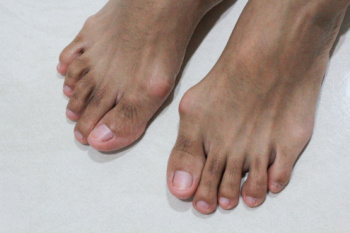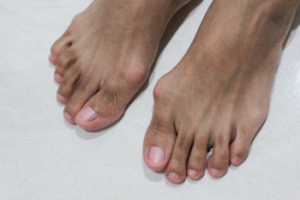Items filtered by date: April 2025
Facts About Bunions

A bunion, or hallux valgus, is a bony bump that forms at the base of the big toe. A bunion develops gradually as the big toe shifts inward toward the smaller toes and places stress on the joint. Because this joint supports a significant amount of weight while walking or standing, people with bunions often experience pain, swelling, and redness in the affected area. In some cases, calluses may form where the toes rub together. Over time, bunions can worsen, making it uncomfortable to wear regular shoes or walk without discomfort. While they are most commonly seen in adults, some children are born with bunions or develop them in adolescence. Factors such as inherited foot structure, joint deformities, and certain inflammatory conditions may contribute to bunion formation. Wearing tight or narrow shoes may not directly cause bunions, but they can aggravate existing ones. A podiatrist can assess the severity of a bunion and recommend treatment, such as supportive footwear, orthotics, or surgery if needed. If you have a bunion that is causing pain, it is suggested that you schedule an appointment with a podiatrist for an exam and appropriate treatment.
If you are suffering from bunion pain, contact Dr. Kenneth Donovan of Advanced Care Foot and Ankle. Our doctor can provide the care you need to keep you pain-free and on your feet.
What Is a Bunion?
Bunions are painful bony bumps that usually develop on the inside of the foot at the joint of the big toe. As the deformity increases over time, it may become painful to walk and wear shoes. Women are more likely to exacerbate existing bunions since they often wear tight, narrow shoes that shift their toes together. Bunion pain can be relieved by wearing wider shoes with enough room for the toes.
Causes
- Genetics – some people inherit feet that are more prone to bunion development
- Inflammatory Conditions - rheumatoid arthritis and polio may cause bunion development
Symptoms
- Redness and inflammation
- Pain and tenderness
- Callus or corns on the bump
- Restricted motion in the big toe
In order to diagnose your bunion, your podiatrist may ask about your medical history, symptoms, and general health. Your doctor might also order an x-ray to take a closer look at your feet. Nonsurgical treatment options include orthotics, padding, icing, changes in footwear, and medication. If nonsurgical treatments don’t alleviate your bunion pain, surgery may be necessary.
If you have any questions, please feel free to contact one of our offices located in Warren, Livingston, and Toms River, NJ . We offer the newest diagnostic and treatment technologies for all your foot care needs.

